Katheryn's Little Red Dress
Saturday, August 11, 2007
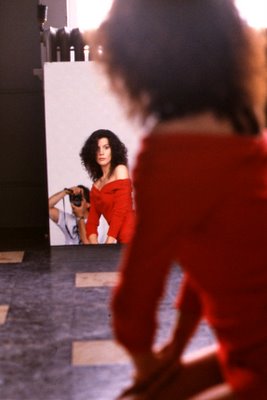 We are what are friends make us. I have come to that conclusion lately. Before I came to Vancouver my knowledge of rock and roll was non existent. It took Les Wiseman a few years to turn me into a Lou Reed fan and to clue me in to American culture. John Lekich introduced me to writers I never knew existed. A. J. Liebling is one of many that I have come to appreciate. When Rosemary and I enjoy an old movie (or a more recent one) on the Turner channel I call up Lekich who always has information that makes the experience of having seen the film even better. And of course both Wiseman and Lekich have been an influence on my fashion tastes. What is the correct T shirt to wear to a punk concert? Should one wear a bow tie with a button down shirt? ("Never!" says Lekich.) 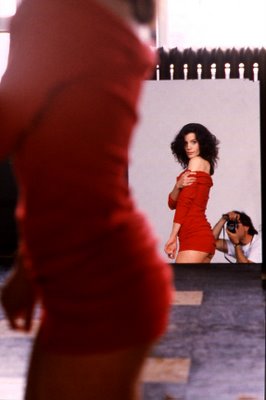 Considering that I opened the files on Katheryn Petersen yesterday (the one woman who made the talkative Robert Blake, Patricia Canning's ex, shut up by simply being there. He became tongue-tied such was the impression of her face on him. I have the opportunity now to modify Lekich's penchant for women who wear that little black dress. 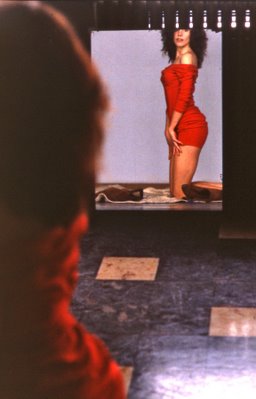 I have here Petersen in her little red dress. What do you say John?
A Flooded Darkroom & Katheryn's Chest
Friday, August 10, 2007
For most of my life I have lived in a brick (or at least cement or concrete ) house. In Mexico City, Rosemary and I lived in a small brick house. We were proud of its solidity. But we chose to move to Vancouver. We were in shock at our first house in Burnaby. For me it was made of cardboard. My friends talked of gyprock and particle board. For me it was glorified cardboard. And the ceilings had "stuff" that looked like miniature stalactites. The shag carpet ( a uniform olive drab) was a black hole for quarters, keys, screws and even camera lens caps. After an unhappy stay in that Springer Avenue house we moved to a "better" one on Athlone Street. But the construction seemed to be no different. Both houses had a basement. Nobody in his right mind in Mexico or Argentina would have a sótano, or would even think of living in one. But there was one luxury. Our Mexico City house in Arboledas had a darkroom that was a bathroom. Now I had a basement darkroom with a bathroom. But that bathroom would cause me grief as would my wet darkroom sink. It got stuck (it is linked to our kitchen sink) with rice and celery stalks I had unwisely garbarated. During the visit of photographer Patrick Hattenburger I could not proudly show him my darkroom. The sink looked like a huge tub of celery and rice soup.
In our 27 years in our Athlone house we have had all kinds of trouble repairing the flimsy "cardboard" construction. Toilets fail, plumbing leaks, the roof has leaked a few times ruining the beautiful vaulted ceiling of our living room (an expensive repair), but in all those years I have managed (more or less, in spite of the rice and celery) to keep my darkroom (in the basement) relatively dry. Until yesterday, of course. Perhaps some of John Lekich's " mala leche", bad luck, rubbed off. Only yesterday he had told me of having flooding basements in Arbutus Village. It seems that the Village was constructed over natural springs and..... I was washing two b+w negatives and the negative washer tilted and fell over. Water was gushing into my darkroom carpet for at least an hour before I realized it. Many of my photographs, stacked in a nearby closet were ruined. I shouted (luckily Rosemary was not around) that my life's work was headed for permanent sogginess. The cats crept under the bed. A trip to Home Depot and a $100 wet/dry vac dealt with most of the water. A portable baseboard heater will probably dry it all up.
Through all the chaos I kept passing by a very large framed photograph of Katheryn Petersen's chest (safely on a wall) posing with Clematis montana. Somehow some of the agony I felt was dissipated.
Anesthetists From Hell
Thursday, August 09, 2007
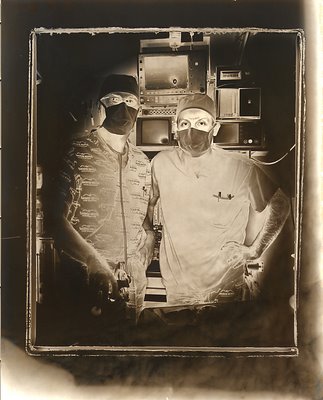 Of late I have been going twice a week to VGH for physiotherapy on my left elbow. I broke it a couple of months back and I cannot stretch the arm to 180 degrees. I am off by 20 but the good news is that a month ago it was by 30. In order to reduce this difference I must go through agonies where my pleasant physiotherapist (either Steve or Maureen) bend my arm in ways that seem to have been inspired by the techniques of Torquemada and his sponsors, the Catholic Kings. The difference may just lie in Maureen and Steve's smiles. They are genuine. They are trying to help me. After avoiding the hospital for 32 years I wonder if this new frequency spells a trend in my life. If it does it could not happen in a better place. I find the facilities and the people of our local hospital to be professional, efficient and in a positive way, easygoing. It is easy to contrast it with my one experience with a Mexican Health Service hospital in the late 60s. I went to visit an uncle, Román Forment. He was in a ward with other sick men. I was having a chat with him when a nurse appeared and quite rudely, "I would appreciate some silence as the man in the next bed is dying." If I had been in the place of the dying man I would have died right then and there. On the other hand, when the morning of my day surgery (a hole was made on my outside left elbow to retrieve and take out a bone chip lodged on the other side) my surgeon asked me which elbow it was and then marked it with a pen I kind of wondered. He was very quick to explain that this simple procedure would help to prevent one of the most common ocurrences in operating tables around the world. This is the operation or the (perhaps?) amputation of the wrong limb. Until my recent operation the closest I ever got to one was some years ago when I photographed a couple of anesthetists at VGH for an article in the Georgia Straight. I lay on the table with fish-eye equipped camera to take this photograph which to me was a possible nightmare from hell. Before my operation a month and a half back I told the anesthetist to not put me to sleep. Such was the feeling of lazy euphoria that came over me with his partial application of the tool of his trade, that it ocurred to me that I should book a friendly operating table soon. 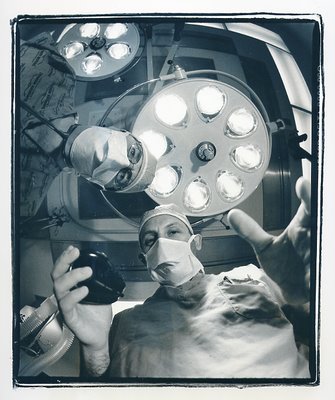 An added bonus of that first anesthetist photograph was that I learned to appreciate the excellent use of VGH scrubs as pajamas for going down to the kitchen to look for a bedside snack. By hook or by .... I own three pair of middle blue scrubs that say Property Of Vancouver General Hospital. Someone should market them and sell them in stores.
Banishing Our Shadows
Wednesday, August 08, 2007
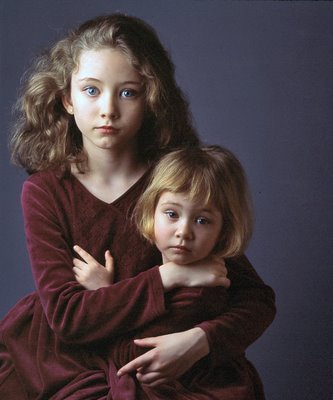 From my bed I find myself looking at this recent framed photograph of Rebecca and Lauren wearing their wine-coloured dresses. I don't try to make these pages a place where I pontificate on the dos and don'ts of photography. But I will note some disturbing (for me) trends. One of them came to mind as I stared at Rebecca and Lauren on the wall. Flemish painting seemed to glorify God's light which was the light coming through a window. Until the advent of gas and electricity, candles ( Abraham Lincoln used a flickering fire place to read ) and window light where the only lights available. Flemish painters painted all the nuances of window light as it revealed or hid a person's face. These nuances depended on the gentle rotation of the face in relation to the window light. A slight triangle of light underneath the dark side of the face was given the name of Rembrandt lighting. In the 20th century as photography prospered with the ubiquity of electric light, flashbulbs and then electronic flash, hiding the human face, or lighting it completely became intelligent options. The professional photographer (or portrait painter) when comissioned to photograph or paint a man of importance (who happened to be fat) would resort to narrow lighting. By darkening one side of the subject's face the round face would halved and the man would look thinner. To further this effect the photographer would place the camera closer to the dark side of the face. A few years back I had to photograph the rather chubby CEO of Weldwood a Canadian forestry firm and I used narrow lighting. The problem was the communications officer who kept telling me, "Alex, why is one side of his face dark? Can you eliminate that?" I could not tell him, "Your boss is fat and I am trying to make him less so." Now that all digital cameras have that convenient built-in flash most of the pictures we see on the web or in magazines that have a gossip column section, sport that on-camera flash look. Faces are lit equally on both sides. The overall result is that faces lose that idea of three dimensionality that the shadow adds by hinting at curvature. Faces look flat. We are getting used to this. Note the lighting of Rebecca's Pink Samsung. The film noir look was based on the use of complex lighting, shadows and projected venetian blinds on spiraling staircases. This lighting was expensive as actors could not move much during their dialogue. In the 60s, with the advent of cheap movies for TV, a blanket wide lighting was used. Shadows disappeared and we called it the made-for-TV look. Soon even first rate movies had that look. Our memory for the dark side, for shade, for shadow is receding. Everything is Flickr or the My-Space look. Will we soon banish our own shadows?
The Dam Camel
Monday, August 06, 2007
 The Camel
The Camel
The camel has a single hump;
The dromedary, two;
Or else the other way around.
I'm never sure. Are you?
Primrose Path, 1935
Odgen Nash
Not far from a lake, at Buchanan Dam in the Texas Hill Country, where my friend Howard Houston lives with his wife Lynne and dog Yogi we met up with this out of context animal.

Before the making of the Isthmus of Panama, camels roamed in an early North America. Thus I have found out that the presence of the camel is not all that out of context.

When North America was joined to South America the camels drifted south and evolved into llamas, guanacos, alpacas and vicuñas.

While riding a calesa, a horse driven buggy in Mérida, Rosemary asked me for the Spanish equivalent of a highway lane divider. It immediately made me think of the Texan camel as the word in Spanish, camellón, is intimately related to the animal.
Hellish Jarring Sounds
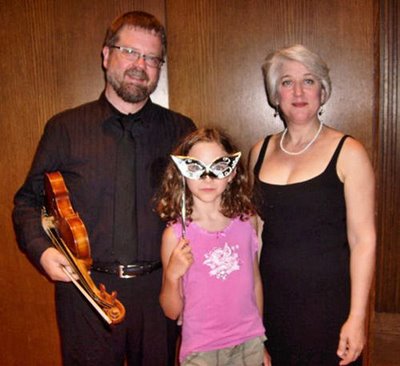 In 1965 I was madly in love. The intensity was more so as the young woman I had fallen for was leaving Buenos Aires for London. It was a curious (and less dramatic) reverse of the man in uniform (Argentine navy) and separation. I was to stay, with no war in sight, and she was going to London to study art. The day arrived complete with a tearful parting at the ship's gangplank and that final wave of my arm as the ship faded in the horizon. I went home and played Miles Davis Kind of Blue. I have always thought that pursuing depression with the help of music can be an exquisite experience. Perhaps the experience empties us and gives us the capacity for joy again. In that respect I can understand the melancholy streak of John Dowland's (1563-1623) music as we (Abraham Rogatnick, Graham Walker, Rebecca Stewart and I) listened to La Cetra, David Douglass, Paul O'Dette and Helen Hargis in last night's performance of "Fine Knacks for Ladies": Courtly Songs & Dances of John Dowland. The venue was the intimate UBC Recital Hall, a place where Rebecca (she was 5 then) and I first saw David Douglass (at the time he was wearing his ubiquitous and favourite blue silk shirt) and noted that he rested his baroque violin, not near his chin, but by his heart. We also noted that in this position he moved very much like a dolphin in water. His wife Helen Hargis had a sweet soprano that could switch from joy to passion and from passion to despair. Whenever either of them come to Vancouver Rebecca and I sit on the first row. And so it was last night. The evening had a happy beginning. Abraham drove us to the concert. He has a blanket permission (for life, as en ex professor of architecture ) to park anywhere at UBC and his secret parking spot was but a few yards from the concert hall. But the beautiful (and so intimate) concert went from more or less sad to a second part called The Mask of Despair where Hargis's face twisted into an intense sadness that it was Kind of Blue all over again. Looking at Rebecca and listening to the lyrics: In darkness let me dwell, the ground shall sorrow be;
The roof despair to bar all cheerful light from me;
The walls of marble black, that moistened still shall weep;
My music hellish jarring sounds to banish friendly sleep.
Thus wedded to my woes, and bedded to my tomb,
O let me living die, till death, till death do come.I felt happy in a melancholy way. But then little girls know better. In the back seat home, Rebecca happily sang: 99 bottles of beer on the wall.....And the moment was past.
Stukas, Corn-On-The-Cob Skewers & A Chocolate Ice Cream Soda
Sunday, August 05, 2007
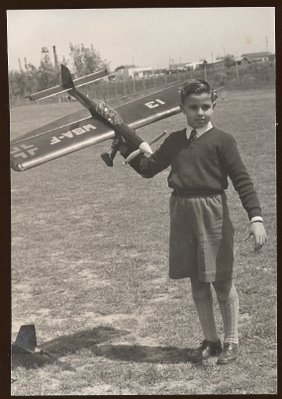 When my father left the house in 1950, my immediate family was my mother and my grandmother. I looked forward to those weekends when my Uncle Tony, cousin Wenceslao and his mother, my Tía Sarita, would spend the day with us. Uncle Tony, Wency and I would go to General Electric Field to fly U-control planes. We didn’t do any of the flying but we pretended. 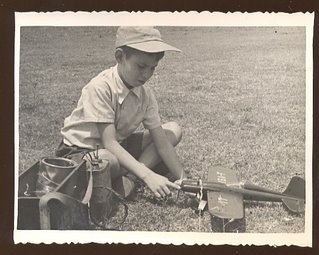 Uncle Tony had perfect scale models (except the wings had to be bigger for the planes to fly) of P-51 Mustangs, P-40 Warhawks (painted in perfect camouflage, sky blue underneath, olive drab on the top and with menacing open teeth on either side of the cowling), a big and black Ju87 Stuka and a highly unstable (Uncle Tony insisted in keeping the original wing design) Fw 190 Focke-Wulf. This was my family. 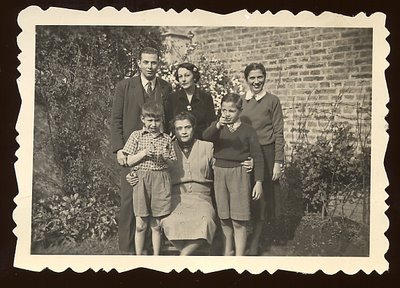 On my birthdays my father’s side of the family would come and the O’Reilly cousins would destroy my brand new toys. I only remember seeing my first cousin and godmother Inesita once but since then we have become very close. Four years ago Rosemary and Rebecca met her and the O'Reilly clan when we went to Argentina. When we lived in Mexico, my mother, grandmother and I would go to weekend parties at the Filipino ambassador’s residence (the Escuderos and the Ezpeletas). The Filipino community became my family. My favourites were the Mirandas (Tío Luís, Tía Fermina and her four children Robby, Carmencita, Luisito and Chayo, who is my daughter Hilary’s godmother). I learned to appreciate Filipino food and on occasions I even wore a barong tagalog (as seen, below) shirt made of pineapple fibre. The black-haired girl is Rosario (Chayo) Miranda and the other girl is my first cousin Shelley Humphrey. 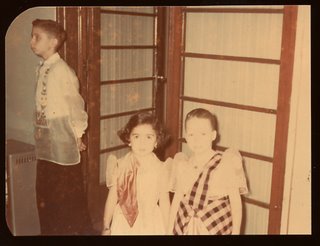 The best of all family gatherings was going to Tía Fermina’s house. There she had several tables all laid out including one for the children. The food was always the best. Filipino dishes mixed with steaks, and Spanish pucheros or the Filipino version called sinigán. Desserts included ensaimadas and upside down pineapple angle food cakes that almost levitated on the table they were so light. And at all times, Tío Luís would point his crooked finger at Rosemary and mention, “Esta hija no a comido nada!” And he would then pressure my wife to eat more. At these gatherings we always had the happy presence of Raúl Guerrero Montemayor who was to share with Chayo (Tía Fermina and Tío Luis’s youngest daughter) the task of being grandparents to Hilary. A few weeks ago Tía Fermina died in Houston and those family gatherings at her side have remained as warm memories. The task is to find some sort of replacement. I find it so important to feel part of a family. In Vancouver my family has been reduced by one with my eldest daughter Ale now living in Lillooet. In spite of her absence, yesterday was a perfect day. Rosemary, Rebecca, Lauren and I went to Richmond to swim in Paul Leisz’s swimming pool. His girlfriend Amy had bought a box of Tim Horton’s doughnuts. Paul served iced tea. I dunked Rebecca in the pool several times. For dinner, at home, I prepared iced tea (from scratch with Russian caravan tea leaves, lemons, tangerines, cloves, cinnamon, fresh mint and nutmeg), Mexican rice, shish kabobs and grilled corn on the cob and asparagus. But it was the dessert that put a finish to a perfect afternoon in the garden. I asked Rebecca if she wanted a chocolate ice cream soda. We had savoured a pair of perfect strawberry ice cream sodas in Mérida at Pops (Calle 57, 60 x 62) and she now understood that the true ice cream soda, without the cloying sweetness of a coke or seven up float, is one of the perfect drinks for a hot day. As we were savouring our drinks (made with San Pellegrino, of course), Lauren looked at me and asked, "Can I have an ice cream soda?" She did. Below is a pair of corn on the cob skewers that have been in my family since 1955. When the Filipino ambassador, Mariano Ezpeleta finished his tour of duty in Mexico City he put much of his household stuff for sale. My mother purchased his silver plate. While these skewers are all that remain to physically remind me of those wonderful afternoons in Mexico City they are also a favourite of Lauren's. Perhaps some day she may remember them in a similar context: A perfect day with the family. 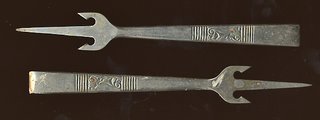
|























